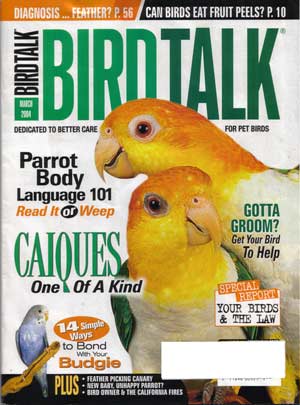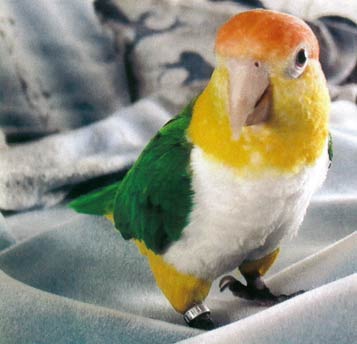About the White
Bellied Caique
Caiques
(pronounced kye-eeks or Kye-ee-kayes) belong to the psittacine
genus Pionites. White-bellied caiques comprise three
sub-species: Pionites leucogaster, P. l. xanthomeria,
and P. l. xanthurus.
Description:
The white-bellied caique is a small parrot, averaging 23 cm
in length and 165 g in weight. With a helmet of bright orange
feathers, a brilliant yellow chin and snowy white breast, white-bellies
are certainly one of the most colorful small parrots. There
are color features that distinguish the three white-bellied
sub-species. All have white underparts, but some differ in tail
and thigh coloration. P. l. xanthomeria has yellow thighs
and a green tail. The back and wing feathers are dark green,
with wing coverts deep blue.
Range:
White-bellies
are native to Brazil and parts of Peru and Bolivia. They prefer
lowland forests near watercourses. Very social, white-bellied
caiques travel in pairs or family groups, feeding on rainforest
fruits, nuts, vegetation and seeds. Like most parrots, white
bellied caiques like to nest in cavities high in the canopy
of rainforest trees. These parrots lay anywhere from two to
four small white eggs which the female incubates. Incubation
lasts around 26 days, during which the female rarely leaves
the nest. The male will forage and feed her while she sits the
eggs. The chicks hatch blind and helpless and both parents feed
and care for them. At about 14 weeks of age the chicks are ready
to leave the nest to begin foraging and feeding on their own.
Habitat:
Like
so many species of plants and animals in the region, the white
bellied caique is threatened with shrinking habitat, as Brazil
is losing rainforest at an alarming rate. The wholesale destruction
of habitat has contributed to the decline of countless rainforest
species, and if left to continue will surely lead to the extinction
of many. Artificial
Incubation:
Nest boxes are checked daily during the breeding season, which
in Florida begins in January and usually ends in June. Eggs
are removed by 0900 hours and are weighed, measured for length
and width, labeled for species, date and cage number and placed
in an avian incubator. The incubator is maintained at (99.9
F) with 50% humidity. Chicks hatch on the 26th day of incubation.
Upon hatching, chicks are weighed, color-coded with a non-toxic
marker and placed in individual plastic cups lined with soft
absorbent cotton. Hatchlings are placed in an avian brooder
set at (97 F) and saturation humidity. Brooder temperatures
are lowered with chick age, usually in three to five degree
increments. Once chicks are feathered, brooder temperatures
are set to ambient room temperature.
Hand-feeding:
Upon hatching, white-belly chicks are fed every 90 minutes
around-the-clock for the first five to seven days. The chicks
are fed a commercial parrot hand-feeding formula prepared
fresh for each feeding. Syringes are used to feed the formula,
which is heated to (100-105 F). Growth patterns indicate that
within the first five to seven days, a weight gain of 15-20%
over a single 24-hour period becomes a benchmark for future
development. Upon achieving this daily growth rate, chicks
"take off", and weight gains are usually sustained
at roughly 15% for the next few weeks. After the first week,
chicks are fed roughly every 2 1/2 hours, or whenever the
crop is completely empty. After the first four to five weeks
chicks should be fed four times per day. Weaning usually begins
by week ten, with chicks fully weaned by 14 weeks of age.
Feedings are gradually reduced at this time, and dietary additions
such as millet spray, banana, soaked monkey biscuits, whole
wheat breads, cooked rice, beans and pasta, as well as the
full adult diet of seeds and fruits are offered daily.
|









